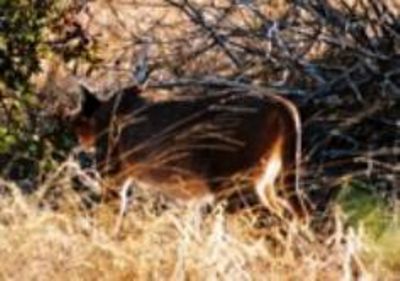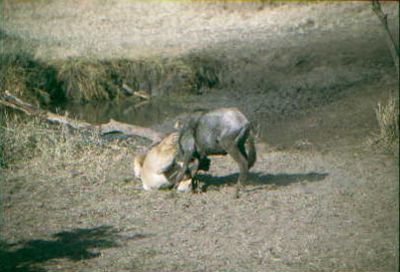
Report from Phil Crosby

Tsavo Lions and other big cats
By Phil Crosby, 24 th March 2003
In Summer 2002 I had the opportunity to spend some time on a project in Kenya, the aims of which were to investigate the causes of manelessness in the male Lions of the Tsavo region. For most of us, the classical mental picture of a male Lion is with a luxuriant mane, very much a symbol of virility in the King of Beasts. The lions in Tsavo are however different - the males typically have only a scruff of beard and sometimes none at all: this does occur elsewhere but usually only in sub-dominant males. An additional feature of the research over time will be the study of how local farmers and herdsmen can predict and avoid human/lion conflicts: at present the lions in Tsavo kill hundreds of livestock each year and some farmers have been forced to convert their holdings to crops. In order to continue to maintain safe havens for wildlife, reserve managers must find ways to minimize lions’ conflict with humans, and to mitigate the consequences when they do meet.
The study itself is funded by Earthwatch (www.earthwatch.org) a charity which has a long history of scientific research, but also of directly involving the public in scientific field research. This study is led by Dr Bruce Patterson (Field Museum of Chicago), Dr Roland Kays (New York State Museum) and Dr Samuel Kasiki (Tsavo Research Centre). Work to date has already established that the lions in Tsavo have a unique social system, featuring single-male prides rather than the larger multi-male prides found elsewhere. Also chronic injuries such as broke teeth, which have often been used to explain stock-stealing or man-eating in the past, do not explain modern instances of these behaviours in Tsavo. (Those of you who watched the movie "The Ghost and The Darkness" about two man eating lions in Kenya may be interested to know that it is very much based in truth and is still a vivid folk memory in Tsavo, where these events occurred. These two very large, maneless males killed hundreds of people during the building of the Mombassa-Nairobi railway). The lions in Tsavo, besides being maneless, are also larger than the average lion and quite aggressive hunters - possibly a result of small social units resulting in greater self-dependence when hunting.
The fieldwork was conducted in two small groups, based from a remote campsite. We heard lion calling most nights and sometimes leopard too: on one occasion a leopard walked through camp during dinner. The groups would travel independently, trying to locate the lions by a combination of telemetry (using radio collars) and calling (the noise of an abandoned buffalo calf). Sadly the buffalo calf call was spectacularly unsuccessful so reliance was on telemetry and spotting. The bush is very dense in Tsavo so even with telemetry it was not always easy to locate the lions - in one instance we drove 360o around where they were and were unable to spot them despite being within less than 10 metres: when they moved we were able to count 1 male and five lionesses who had been invisible to us moments before! Once we located lions we recorded behaviour, hunting activity etc from a respectful distance so as not to interfere with their normal behaviour. We observed them hunting, just relaxing and even playing. We also, in our daily (and nightly) rounds of the reserve, made a rough census of other species to record prey species and other predators: as this part of the reserve was not open to tourists, and not at all for night safaris, we were able to observe animals not often seen on regular safari trips. Despite the low density of most animals in the region when compared to the Serengeti or Masai Mara, it was almost like a safari holiday, with the added aspect of benefiting scientific research.
There were some frustrations - elements of the research were under-prepared, and progress had been minimal in some ways. However, this was part way through the first year of an anticipated 5 year plus study so I will be watching with interest how things develop. I may even re-visit next year to see what progress has been achieved.
If any of you have any interest in doing anything similar, do check out the Earthwatch website www.earthwatch.org - they have several programmes focussed around big cats (Lions, Cheetah and Puma) but many more covering things as diverse as bats and dolphins, birdlife and whales. Geographically the projects listed for 2003 cover 5 continents. Costs are not particularly cheap but the costs compared well to a normal two week safari trip, and a significant element of the money paid goes directly to the research programme.
Photos
 |
| Pride male "Romeo" - this was taken just after dawn. We spent two hours prior to dawn sitting in Land Rovers listening to him roar just a few feet away, and having ourselves stalked by two of the younger lionesses. He is a big young male - the rangers said that when they collared him for telemetry he measured 9 feet over curves. |
 |
| This is one of the two curious young lionesses who stalked us one night before dawn. She came right up to the window and put her face up to the glass! And yes it did make us jump! |
 |
 |
| We were lucky to see this Cheetah, way off in the bush at first but then it came down and crossed the road ahead of us and rested up by the water. |
 |
| This leopard was sat in a tree with an antelope she had killed recently |
 |
| This is a caracal – just a fleeting glimpse as he walked away but you can see the musculature of his hindquarters and the tufted ears. |
 |
 |
| We watched this lioness stalk a herd of around 30 Wildebeest and then attack this adult on her own. In most areas a lion would hunt something as large as a Wildebeest in a small group. |
Phil Crosby
Phil Crosby, 24 th March 2003
 |
 |
 |
| Return to index | Return to Scottish Big Cats | Return to Research and Education |